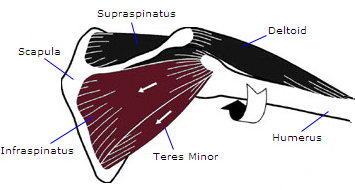-
Strengthen Your Rotator Cuff
Roughly 5 years back I tear my rotator cuff, I found ways to build the rotator cuff and felt through the pain. One of the items I started using to strengthen the should cuff was the horn, Listed below are the finding pertaining to the shoulder horn. I do this excursive before benching helps in strengthening, enjoy the reading, oh yeah the video added was with a chick makes the video worth watching (ha)
What we commonly call the "shoulder joint" is referred to by doctors as the gleno-humeral (GH) joint. This is the point where your upper arm (i.e. humerus) attaches to the lateral end of your shoulder blade (i.e. scapula). Most of your shoulder's motion is due to movement of your arm at the GH joint. The remainder is caused by smaller movements of the scapula.The GH joint is a shallow ball-and-socket joint that allows your arm to move freely in all directions. This joint's inherent flexibility, however, makes it relatively unstable. It's function depends heavily on the coordinated strength of the surrounding muscles.Your deltoids, pectorals, latissimus dorsi, teres major, and rotator cuff muscles (subscapularis, supraspinatus, infraspinatus, and teres minor) all cross the shoulder joint and attach to your upper arm. In addition to moving your arm, they help hold its proper position in the GH joint. Because these muscles have different origins of attachment, each one, like the guy wires, pulls your arm in a different direction.Shoulder muscles are commonly classified as being either internal rotators or external rotators. The largest shoulder muscles, including the pectorals, latissimus dorsi, and teres major, are all internal rotators. This means that in addition to moving your arm forward or backward, they also cause some inward rotation of your arm. The corresponding external rotation is produced almost entirely by two small muscles of the rotator cuff -- the infraspinatus and the teres minor.

Use the ShoulderHorn to Isolate and Strengthen Your External Rotators
|
| The external rotation exercise is similar to a tennis backhand stroke -- your elbow is bent 90 degrees and stays in one position, while your hand and forearm pivot backward. This exercise can be done either with your upper arm held flat against your side or with your arm partially raised (horizontally abducted). From an athlete's standpoint, there are two compelling reasons to perform this exercise in the abducted position: |
- Better neuromuscular preparation for overhead exertion
Horizontal abduction better approximates the position of your shoulder when it's under greatest load during the lifting, throwing, and overhead motions common to many sports (e.g. baseball, football, weight lifting, tennis, swimming). Performing the exercise in an abducted position better conditions your external rotators to respond appropriately when most needed. - Relief of supraspinatus compression
One of your other rotator cuff muscles -- the supraspinatus -- occupies a confined space along the top of your scapula, and can experience compression-induced disruption of its blood supply when forces are applied to your shoulder in a fully adducted (arm down) position. This potential problem is eliminated by use of the abducted position.
|
External rotation in an abducted position should only be done with proper support, however. If the weight of your upper arms isn't completely supported, other muscles of your shoulder and upper back (e.g. deltoid, trapezius) will activate and decrease the amount of benefit your infraspinatus and teres minor receive from this exercise. In addition, if the position of your upper arm is to high or too far back, there's a risk of impingement between your humerus and acromion (the hook-shaped bone structure at the top of your scapula).
The ShoulderHorn automatically locks your shoulders and arms in the safest and most effective position for abducted external rotation. The ShoulderHorn has also been clinically proven to be significantly more effective for increasing external rotator strength than dumbbells alone.
Use the ShoulderHorn with a pair of hand-held weights, as shown below. Beginners may use as little as 2 lbs of weight for this movement, and even the strongest athletes will need less than 20 lbs. For this reason, a small medicine ball, or even a can of soup, can provide suitable resistance if dumbbells aren't available. A training booklet, included with the ShoulderHorn, provides additional details on this exercise and how to best incorporate it into your training or rehabilitation schedule.
reference: http://www.shoulderhorn.com |
-
Post Thanks / Like - 3 Thanks, 0 Likes, 0 Dislikes
----


























































 Reply With Quote
Reply With Quote

Bookmarks